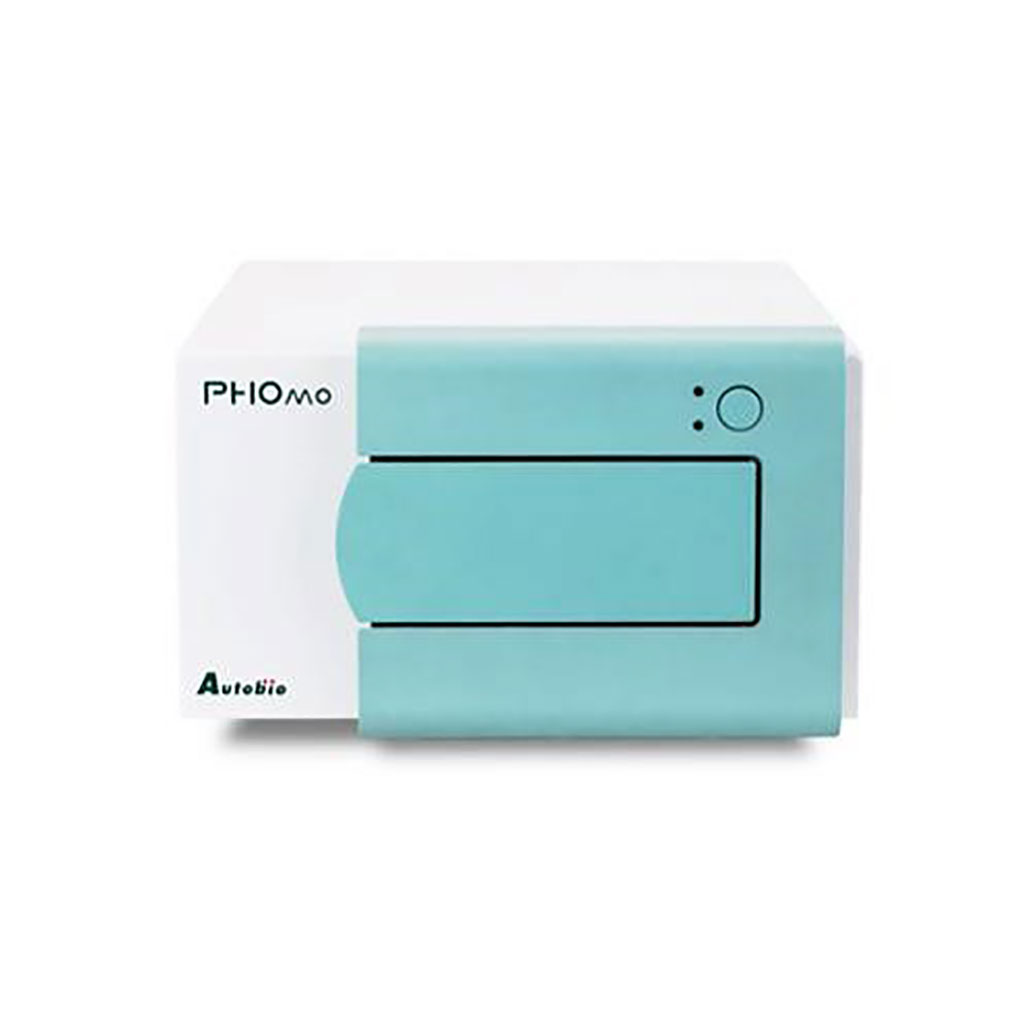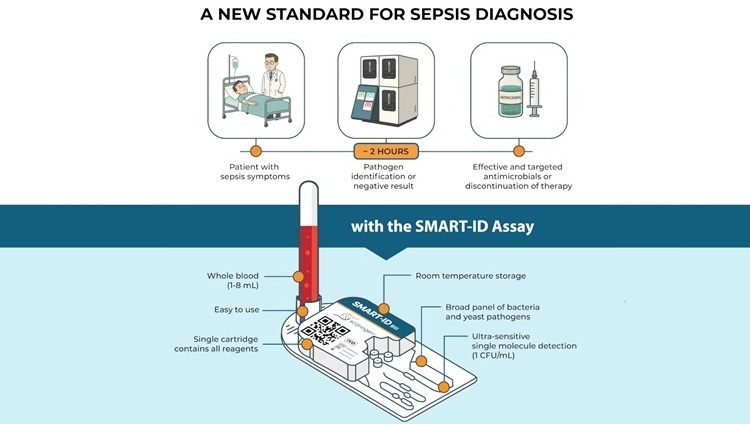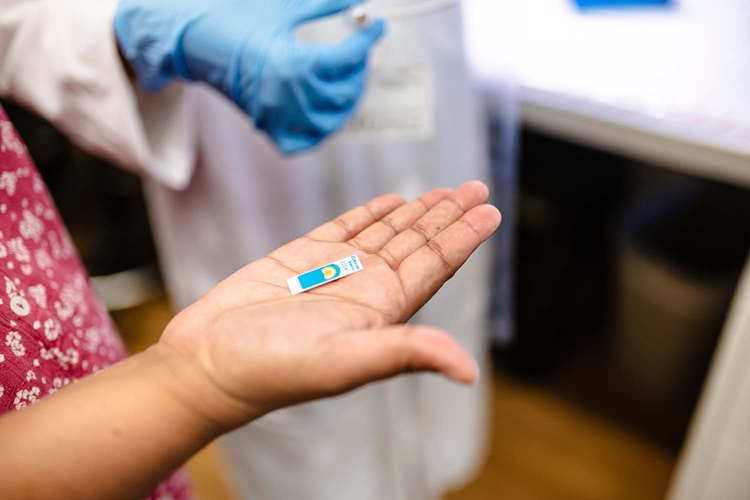Urea Dissociation Tests Reduces SARS-CoV-2 IgM False-Positives
|
By LabMedica International staff writers Posted on 28 Apr 2020 |

Image: The PHOMO Microplate Reader: the sophisticated optical design combined with the accurate plate transport system allows for high resolution scanning (29 points per well) to support agglutination assays (Photo courtesy of Autobio Diagnostics Co).
At present, the diagnosis of COVID-19 is mainly based on epidemiological history inquiry, laboratory testing, and chest radiology examination. Among these examinations, the detection of nucleic acid from SARS-CoV-2 is the direct evidence for COVID-19 diagnosis.
The detection of serum-specific IgM and IgG, especially the former, is routinely used in clinical laboratories to evaluate the acute phase infection of pathogens in the serum. In many infections, IgM can be detected as early as one week after infection. When the level of IgM reaches the detection limit of the assay kit, the detection of IgM can avoid false-negative results owing to sampling.
Medical Laboratory Scientists at the Affiliated Hospital of North Sichuan Medical College (Nanchong, P.R. China) used gold immunochromatography assay (GICA) and enzyme-linked immunosorbent assay (ELISA) to detect SARS-CoV-2 IgM in 86 serum samples, including five influenza A virus (Flu A) IgM-positive sera, five influenza B virus (Flu B) IgM-positive sera, five Mycoplasma pneumoniae IgM-positive sera, five Legionella pneumophila IgM-positive sera, six sera of HIV infection patients, 36 rheumatoid factor IgM (RF-IgM)-positive sera, five sera from hypertensive patients, five sera from diabetes mellitus patients, and 14 sera from novel coronavirus infection disease (COVID-19) patients.
The interference factors causing false-positive reactivity in the two methods were analyzed, and the urea dissociation test was employed to dissociate the SARS-CoV-2 IgM-positive serum using the best dissociation concentration. The IgM against Flu A and B, M. pneumoniae, and L. pneumophila were detected by indirect immunofluorescence assay (Respiratory tract 8 joint detection kit, EUROIMMUN, Inc., Lübeck, Germany). Rheumatoid Factor (RF-IgM) was detected by rate nephelometry assay (IMMAGE800, Beckman Coulter, Inc., Brea, CA, USA). HIV combi PT was detected by electrochemiluminescence assay (Cobas E602, Roche, Mannheim, Germany).
GICA and ELISA were used for SARS-CoV-2 IgM detection (kit provided by Beijing Hotgen Biotechnology Co., Beijing, China). Optical density in ELISA plates was measured using a PHOMO Microplate Reader (Autobio Diagnostics Co., Zhengzhou, China). Urea dissociation tests of GICA and ELISA were also performed.
The team reported that both GICA and ELISA detected positive SARS-CoV-2 IgM in 22 middle-high level RF-IgM-positive sera and in all the 14 sera from the patients with COVID-19 patients. The other 50 sera were negative. When urea dissociation concentration was 6 mol/L, SARS-CoV-2 IgM was positive in one middle-high level RF-IgM-positive sera and in the 14 COVID-19 samples detected using GICA. When urea dissociation concentration was 4 mol/L and the avidity index (AI) lower than 0.371 was set to negative, test results were positive for SARS-CoV-2 in 3 middle-high level RF-IgM-positive sera, as well as the 14 COVID-19 sera detected using ELISA.
The authors concluded that middle-high level of RF-IgM could lead to false-positive reactivity of SARS-CoV-2 IgM detected using GICA and ELISA, and urea dissociation tests would be helpful in reducing false-positive results of SARS-CoV-2 IgM. The study was published on April 10, 2020 in the Journal of Clinical Microbiology.
The detection of serum-specific IgM and IgG, especially the former, is routinely used in clinical laboratories to evaluate the acute phase infection of pathogens in the serum. In many infections, IgM can be detected as early as one week after infection. When the level of IgM reaches the detection limit of the assay kit, the detection of IgM can avoid false-negative results owing to sampling.
Medical Laboratory Scientists at the Affiliated Hospital of North Sichuan Medical College (Nanchong, P.R. China) used gold immunochromatography assay (GICA) and enzyme-linked immunosorbent assay (ELISA) to detect SARS-CoV-2 IgM in 86 serum samples, including five influenza A virus (Flu A) IgM-positive sera, five influenza B virus (Flu B) IgM-positive sera, five Mycoplasma pneumoniae IgM-positive sera, five Legionella pneumophila IgM-positive sera, six sera of HIV infection patients, 36 rheumatoid factor IgM (RF-IgM)-positive sera, five sera from hypertensive patients, five sera from diabetes mellitus patients, and 14 sera from novel coronavirus infection disease (COVID-19) patients.
The interference factors causing false-positive reactivity in the two methods were analyzed, and the urea dissociation test was employed to dissociate the SARS-CoV-2 IgM-positive serum using the best dissociation concentration. The IgM against Flu A and B, M. pneumoniae, and L. pneumophila were detected by indirect immunofluorescence assay (Respiratory tract 8 joint detection kit, EUROIMMUN, Inc., Lübeck, Germany). Rheumatoid Factor (RF-IgM) was detected by rate nephelometry assay (IMMAGE800, Beckman Coulter, Inc., Brea, CA, USA). HIV combi PT was detected by electrochemiluminescence assay (Cobas E602, Roche, Mannheim, Germany).
GICA and ELISA were used for SARS-CoV-2 IgM detection (kit provided by Beijing Hotgen Biotechnology Co., Beijing, China). Optical density in ELISA plates was measured using a PHOMO Microplate Reader (Autobio Diagnostics Co., Zhengzhou, China). Urea dissociation tests of GICA and ELISA were also performed.
The team reported that both GICA and ELISA detected positive SARS-CoV-2 IgM in 22 middle-high level RF-IgM-positive sera and in all the 14 sera from the patients with COVID-19 patients. The other 50 sera were negative. When urea dissociation concentration was 6 mol/L, SARS-CoV-2 IgM was positive in one middle-high level RF-IgM-positive sera and in the 14 COVID-19 samples detected using GICA. When urea dissociation concentration was 4 mol/L and the avidity index (AI) lower than 0.371 was set to negative, test results were positive for SARS-CoV-2 in 3 middle-high level RF-IgM-positive sera, as well as the 14 COVID-19 sera detected using ELISA.
The authors concluded that middle-high level of RF-IgM could lead to false-positive reactivity of SARS-CoV-2 IgM detected using GICA and ELISA, and urea dissociation tests would be helpful in reducing false-positive results of SARS-CoV-2 IgM. The study was published on April 10, 2020 in the Journal of Clinical Microbiology.
Latest Immunology News
- Routine Blood Test Can Predict Who Benefits Most from CAR T-Cell Therapy
- New Test Distinguishes Vaccine-Induced False Positives from Active HIV Infection
- Gene Signature Test Predicts Response to Key Breast Cancer Treatment
- Chip Captures Cancer Cells from Blood to Help Select Right Breast Cancer Treatment
- Blood-Based Liquid Biopsy Model Analyzes Immunotherapy Effectiveness
- Signature Genes Predict T-Cell Expansion in Cancer Immunotherapy
- Molecular Microscope Diagnostic System Assesses Lung Transplant Rejection
- Blood Test Tracks Treatment Resistance in High-Grade Serous Ovarian Cancer
- Luminescent Probe Measures Immune Cell Activity in Real Time
- Blood-Based Immune Cell Signatures Could Guide Treatment Decisions for Critically Ill Patients
- Novel Tool Predicts Most Effective Multiple Sclerosis Medication for Patients
- Companion Diagnostic Test for CRC Patients Identifies Eligible Treatment Population
- Novel Tool Uses Deep Learning for Precision Cancer Therapy
- Companion Diagnostic Test Identifies HER2-Ultralow Breast Cancer and Biliary Tract Cancer Patients
- Novel Multiplex Assay Supports Diagnosis of Autoimmune Vasculitis
- Blood Test Predicts Immunotherapy Efficacy in Triple-Negative Breast Cancer
Channels
Clinical Chemistry
view channel
Online Tool Detects Drug Exposure Directly from Patient Samples
Doctors often rely on patient interviews and medical records to determine what medications a person has taken, but this information is frequently incomplete. People may forget drugs they used, take over-the-counter... Read more
Chemical Imaging Probe Could Track and Treat Prostate Cancer
Prostate cancer remains a leading cause of illness and death among men, with many patients eventually developing resistance to standard hormone-blocking therapies. These drugs often lose effectiveness... Read moreMolecular Diagnostics
view channel
New 15-Minute Hepatitis C Test Paves Way for Same-Day Treatment
Chronic hepatitis C infection affects an estimated 50 million people worldwide and causes around 242,000 deaths each year, largely due to cirrhosis and liver cancer. Although the infection is curable with... Read more
Ovarian Cancer Assay Outperforms Traditional Tests in Early Disease Detection
Globally, ovarian cancer is one of the deadliest cancers affecting women. Traditionally, early diagnosis of ovarian cancer has been challenging. Many ovarian cancers are diagnosed only after they have... Read moreHematology
view channel
MRD Tests Could Predict Survival in Leukemia Patients
Acute myeloid leukemia is an aggressive blood cancer that disrupts normal blood cell production and often relapses even after intensive treatment. Clinicians currently lack early, reliable markers to predict... Read more
Platelet Activity Blood Test in Middle Age Could Identify Early Alzheimer’s Risk
Early detection of Alzheimer’s disease remains one of the biggest unmet needs in neurology, particularly because the biological changes underlying the disorder begin decades before memory symptoms appear.... Read more
Microvesicles Measurement Could Detect Vascular Injury in Sickle Cell Disease Patients
Assessing disease severity in sickle cell disease (SCD) remains challenging, especially when trying to predict hemolysis, vascular injury, and risk of complications such as vaso-occlusive crises.... Read more
ADLM’s New Coagulation Testing Guidance to Improve Care for Patients on Blood Thinners
Direct oral anticoagulants (DOACs) are one of the most common types of blood thinners. Patients take them to prevent a host of complications that could arise from blood clotting, including stroke, deep... Read moreMicrobiology
view channel
Blood-Based Diagnostic Method Could Identify Pediatric LRTIs
Lower-respiratory tract infections (LRTIs) are a leading cause of illness and death worldwide, and pneumonia is the leading infectious cause of death in children under five, claiming the lives of over... Read more
Rapid Diagnostic Test Matches Gold Standard for Sepsis Detection
Sepsis kills 11 million people worldwide every year and generates massive healthcare costs. In the USA and Europe alone, sepsis accounts for USD 100 billion in annual hospitalization expenses.... Read moreRapid POC Tuberculosis Test Provides Results Within 15 Minutes
Tuberculosis remains one of the world’s deadliest infectious diseases, and reducing new cases depends on identifying individuals with latent infection before it progresses. Current diagnostic tools often... Read more
Rapid Assay Identifies Bloodstream Infection Pathogens Directly from Patient Samples
Bloodstream infections in sepsis progress quickly and demand rapid, precise diagnosis. Current blood-culture methods often take one to five days to identify the pathogen, leaving clinicians to treat blindly... Read morePathology
view channel
Rapid Low-Cost Tests Can Prevent Child Deaths from Contaminated Medicinal Syrups
Medicinal syrups contaminated with toxic chemicals have caused the deaths of hundreds of children worldwide, exposing a critical gap in how these products are tested before reaching patients.... Read more
Tumor Signals in Saliva and Blood Enable Non-Invasive Monitoring of Head and Neck Cancer
Head and neck cancers are among the most aggressive malignancies worldwide, with nearly 900,000 new cases diagnosed each year. Monitoring these cancers for recurrence or relapse typically relies on tissue... Read more
Common Health Issues Can Influence New Blood Tests for Alzheimer’s Disease
Blood-based tests for Alzheimer’s disease are transforming diagnosis by offering a simpler alternative to spinal taps and brain imaging. However, many people evaluated at memory clinics also live with... Read more
Blood Test Formula Identifies Chronic Liver Disease Patients with Higher Cancer Risk
Chronic liver disease affects millions worldwide and can progress silently to hepatocellular carcinoma (HCC), one of the deadliest cancers globally. While surveillance guidelines exist for patients with... Read moreTechnology
view channel
Machine Learning Models Diagnose ALS Earlier Through Blood Biomarkers
Amyotrophic lateral sclerosis (ALS) is a rapidly progressive neurodegenerative disease that is notoriously difficult to diagnose in its early stages. Early symptoms often overlap with other neurological... Read more
Artificial Intelligence Model Could Accelerate Rare Disease Diagnosis
Identifying which genetic variants actually cause disease remains one of the biggest challenges in genomic medicine. Each person carries tens of thousands of DNA changes, yet only a few meaningfully alter... Read moreIndustry
view channel
Abbott Acquires Cancer-Screening Company Exact Sciences
Abbott (Abbott Park, IL, USA) has entered into a definitive agreement to acquire Exact Sciences (Madison, WI, USA), enabling it to enter and lead in fast-growing cancer diagnostics segments.... Read more







 Analyzer.jpg)











